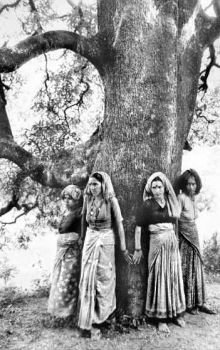A tribal community in India holds a mirror to urban activists by living in perfect harmony with birds, animals and trees
By Gagandeep Ghuman
Last year in November, a photo Indian celebrity chef Vikas Khanna posted on Instagram went viral. It was of a rural Indian woman, in strikingly colourful ethnic clothes and jewellery, sitting in what looked like an open kicthen in her village home, suckling a fawn like her own baby. Khanna wrote: “The greatest form of humanity is compassion” — A Bishnoi woman told me as she had breastfed and saved many orphaned and injured baby deers in her life in the deserts of Rajasthan, India.”
Bishnois are a tribal community which lives a life organically connected with animals and trees. Often, Bishnoi women adopt orphaned fawns and raise them as their own kids. Bishnois can literally get killed to save a tree from getting cut down.
Few in urban India knew about this community that lives mostly in remote villages in the Thar desert till India’s top film star Salman Khan was charged for killing two black bucks—a protected species in India whose killing is punishable under law—in a Bishnoi area while shooting for a film 20 years ago.
For Bishnois, the killing of the black buck was nothing short of a grave sin against their religion of nature. In a country where the high and mighty often manage to escape the law, Bishnois made sure Khan was tried in a court. Last month, the court found Khan guilty of killing the black buck and sentenced him to a five-year jail term on the testimony of a Bishnoi witness.
Khan and his gang of co-stars were challenged by a Bishnoi man while they were out shooting, The film stars fled the spot, leaving behind the carcasses. Bishnois reported them to the police. In cases involving powerful accused, witnesses are ususally pressurised to turn hostile but Bishnois did not give in because it was a matter of faith for them.
Since protecting nature is part of their faith, Bishnois have displayed fierce resistence to killing of animals and cutting of trees. That they can lay down their lives to protect nature is no overstatement. Three centuries ago, a Bishnoi woman, Amrita Devi, did exactly that. A local king ordered cutting down of khejri trees because he needed wood to build a palace. Since khejri trees are especially sacred to the Bishnois, Amrita Devi and her three daughters challenged the royal soldiers by hugging a khejri tree. The soldiers had to kill the woman and her daughters and then hundreds of more Bishnois who too hugged the trees to save them.
The legend of Amrita Devi is said to have inspired a forest conservation movement, Chipko (literally, to hug), in modern India in which women in Himalayan villages similarly hugged trees to save them from loggers.
The legend of Amrita Devi is said to have inspired a forest conservation movement, Chipko (literally, to hug), in modern India in which women in Himalayan villages similarly hugged trees to save them from loggers. Of course, they were not killed. The movement grew into a bigger project against deforestation. The photos of those Himalayan women hugging trees became icons for environment activists all over the world.
The tribal Hindu sect of Bishnoi was started by Guru Jambheshwar of Bikaner in the Rajasthan state in 15th century. He set down 29 tenets which direct the community to protect nature and animals as well as worship God. Killing animals and felling of trees are grave sins for the Bishnoi community.
Typically, a Bishnoi village is a safe sanctuary for all kinds of animals and birds. They let wild animals graze in their farms. Bishnoi youth have formed a wildlife protection organisation called Tiger Force which fights poachers. Many times, Bishnoi temples are used as shelters for injured wild animals and birds. Bishnois don’t cut trees even for fuel for which they use fallen branches and twigs. Nature conservation is an old tradition in the Rajasthan state wher people are known for their innovative water conservation techniques which include intricate step-wells.
Village resorts have cropped up around the city of Jodhpur which offer “Bishnoi village safaris” where one can see various animals and birds freely moving around.
Today, Bishnoi villages draw a large number of tourists for their distinctly ethnic lifestyle. Village resorts have cropped up around the city of Jodhpur which offer “Bishnoi village safaris” where one can see various animals and birds freely moving around.
The Khan case highlighted the disconnect between urban India and its ethnic rural communities which still follow lifestyles that conserve nature. Khan would have thought twice before shooting the black bucks if he had known how fierecly the local Bishnois protect the wildlife.
The case also brought to light the stark difference between the designer activism of many Indian film personalities who often flaunt their concern for wildlife on social media but chose to remain silent on Khan’s conviction and the authentic lifestyle of a community rooted in its environment. For once, Bishnois held a mirror to India’s urban activists whose lifestyles and ideas often veer off in different directions.











Comments
NOTE: The North Shore Daily Post welcomes your opinions and comments. We do not allow personal attacks, offensive language or unsubstantiated allegations. We reserve the right to edit comments for length, style, legality and taste and reproduce them in print, electronic or otherwise. For further information, please contact the editor or publisher, or see our Terms and Conditions.